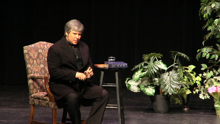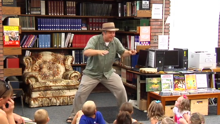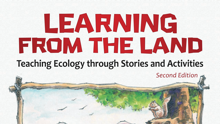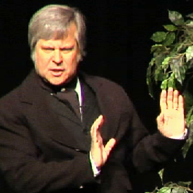By John James Audubon, edited by Brian “Fox” Ellis
Excerpted from Content Area Reading, Writing and Storytelling
Where is the person who, upon seeing this lovely little hummingbird moving on humming winglets through the air, suspended as if by magic in it, flitting from one flower to another, with motions as graceful as they are light and airy, and yielding new delights wherever it is seen––where is the person, I ask of you, who, on observing this glittering fragment of the rainbow, would not pause, admire, and instantly turn his mind with reverence toward the majesty of creation? ––There breathes not such a person; so kindly have we all been blessed with that intuitive and noble feeling––admiration!
Its gorgeous throat in beauty and brilliancy baffles all competition. Now it glows with a fiery hue, and again it is changed to the deepest velvety black. Upon closer inspection the smallest feathers of the ‘ruby throat’ are designed with a slight curvature, much like the mirror a surgeon wears on his forehead to concentrate the light. The feathers, rays, barbs and barbules capture the light, reflect and refract it, like a prism, so that the brightest ruby hue flashes at you if you are facing this flicker of light. The upper parts of its delicate body are of resplendent changing green; and it throws itself through the air with a swiftness and vivacity hardly conceivable. At rest, its heart beats more than 250 times per minute, and when it is flitting about, its heart rate leaps to 1,250 beats per minute!
To balance this exuberance, to conserve energy, when it is cold or asleep, it can slip into torpor, a state of semi-hibernation, where its temperature drops from 110 degrees to 55 degrees Fahrenheit and its heart rate slows to 55 beats per minute. With 75–80 wing beats per second, this gleam of light, moving from one flower to another, is the only bird that can fly backward, one of the few that can hover and does so by moving its wings in a figure–eight pattern. In this manner, it searches the extreme northern portions of our country, following with great precaution the advances of the season, and retreats with equal care at the approach of autumn.
Please participate with me in this migratory math: If the wings beat 75 times per second, and there are 60 seconds in 1 minute, and 60 minutes in 1 hour, and the ruby-throated hummingbird will fly more than 10 hours at night as it crosses the Gulf of Mexico from the tip of the Yucatan Peninsula to the gulf coast, how many wing beats does it take to make this journey? 75 x 60 x 60 x 10 equals 2,700,000 wing beats in one flight across the Gulf of Mexico in its annual spring migration!
No sooner has the warmth of the sun brought the vernal equinox, and millions of plants have stretched their leaves and blossoms, then the little hummingbird is seen advancing on fairy wings, carefully visiting every opening flower-cup. Like a curious florist, he removes from each flower the insects that might cause their beautiful petals to droop and decay. Poised in the air, it is observed peeping cautiously, and with sparkling eye, into their innermost recesses. And the bird, as it leaves the flower, sips so small a portion of its liquid honey that the theft of nectar is looked upon with a grateful feeling by the flower, which is thus kindly relieved from the attacks of her destroyers. The hummingbird has several unique adaptations as an insectivore and nectivore. The tongue attaches to the back of the skull to give it extra length for extension. It is forked, though this is rarely seen, and each fork has tubular channels to aid the bird in the absorption of nectar through capillary action. Can you curl your tongue? Like a dog drinking water, the hummingbird quickly slides its tongue in and out of the flower to draw in the sweet elixir. You can see this in a hummingbird feeder with the ripples created in the surface as the tongue moves rapidly in and out.
In exchange for this sip of nectar the hummingbird gleefully pollinates the flowers. The tubular flowers, honeysuckle and trumpet vine, touch-me-not and cardinal flowers, each offer their honey sweetness to bribe the hummingbird to carry pollen from one flower to another. Upon careful examination, one will see that each flower positions its pistol and stamen so its pollen will dust a different portion of the hummingbird’s head, neck, or throat. The fuchsia will deposit its pollen on the chin while the fire pink dusts the bill, and the jewel weed or touch–me–not places its pollen on the forehead of the little bird. In a busy day of sipping nectar and eating insects the hummingbird’s fairy wings will carry it to many species of plants, but the pollen of each species is carefully stored on the head, the cheek, the underside of the bill or the chin, so when it visits the same species of flower late in the day, the pollen is not wasted, the proper dusting of pollen finds the proper pistol.
The prairies, the fields, the orchards and gardens, nay, the deepest shades of the forests, are all visited in their turn, and everywhere the little bird meets with pleasure and with food. Within its territory this glorious gardener knows where each flower is blooming and makes its rounds with the consistency of a soldier on watch, chasing away any rivals. In the same manner in which the fur trappers of our earliest history would check their trap-line every day, the hummingbird knows which flowers are producing nectar and where the tastiest insects are found. Sipping nectar for energy, they depend on insects for protein. The ruby-throated hummingbird has several means of catching bugs: Like a peregrine falcon it will gather insects on the wing. I have seen it perched on a slender, leafless twig of a dying oak and dart out into a swarm of tiny flies or a cloud of gnats and catch as many as 25–30 gnats in a matter of moments. The hummingbird zips out and snap-snip-snap-snip, snaps up half a dozen gnats before flying back to its perch to enjoy what it has caught. Within a quarter hour it has made a dozen forays into the swarm, more efficient than a tyrant flycatcher! This wise little bird has learned to follow the rounds of the sap sucker and where this woodpecker has made holes in the bark of trees the hummingbird will sip the sap and glean the insects trapped in the sap. Like a nuthatch they will scour the bark and underside of leaves for beetles, larva and eggs. And in a manner similar to some of the woodland warblers and wrens, I have seen the blur of wings whirl-up a rush of wind and roll over the dead leaves on the forest floor. The hummingbird will devour insects thusly exposed.
But what would the hummingbird do without the aid of spiders? The hummingbird will poach insects from the spiders’ webs. And if no other bugs are to be found, the hummingbird will eat the spider! Though I have not seen this with my own eyes, others have said this is a grave risk, for they have seen hummingbirds entrapped by the spider’s web. And of course, the spiders’ web is the glue for making the hummingbird’s nest.
If you have seen these winged jewels then you can imagine the pleasures which I have felt whilst watching the courtship of a single pair of these most favorite little creatures, when engaged in the demonstration of their love to each other––how the male swells his plumage and throat, and, dancing on the wing, whirls around the delicate female; he will fly up and swing down like a pendulum swinging back and forth, then look how quickly he dives towards a flower, and returns with a loaded bill, which he offers to her; how full of ecstasy he seems to be when his caresses are kindly received; how his little wings fan her, and he transfers to her bill the insect and the honey which he has procured with a view to please her; how these attentions are received with apparent satisfaction; how, soon after, the blissful compact is sealed; how, then, the courage and care of the male are redoubled; how he even dares to give chase to the Tyrant Fly-catcher, hurries the Blue-bird and the Martin to their boxes; and how, on sounding pinions, he joyously returns to the side of his lovely mate.
Could you, please, imagine casting a momentary glance on the nest of the Humming-bird, and see, as I have seen, the newly-hatched pair of young, little larger than bumble-bees, naked, blind, and so feeble as scarcely to be able to raise their little bill to receive food from the parents.
The nest of this Humming-bird is of the most delicate nature, the external parts being formed of a light grey lichen found on the branches of trees, all so neatly arranged round the whole nest, as to seem part of the branch or stem itself. These little pieces of lichen are glued together with spiders’ silken strong webs. The next coating consists of cottony substance, and the innermost of silky fibers obtained from various plants, all extremely delicate and soft. On this comfortable bed the female lays only two eggs, which are pure white and almost oval. Ten days are required for their hatching, and the birds raise two broods in a season. In one week the young are ready to fly, but are fed by the parents for nearly another week. They receive their food directly from the bill of their parents, which disgorge it in the manner of canaries or pigeons. It is my belief that no sooner are the young able to provide for themselves than they associate with other broods, and perform their migration apart from the older birds, as I have observed twenty or thirty young Humming-birds resort to a group of trumpet-flowers, when not a single old male was to be seen.
They do not receive the full brilliancy of their colors until the succeeding spring, although the throat of the male bird is strongly imbued with the ruby tints before they leave us in autumn.
I have seen many of these birds kept in partial confinement, when they were supplied with artificial flowers made for the purpose, in the corollas of which water with dissolved sugar was placed. One does not live on sugar alone; they seldom lived many months. On being examined after death, they were found to be extremely emaciated. Others, on the contrary, which were supplied twice a-day with fresh flowers from the woods or garden, placed in a room with windows merely closed with mosquito gauze-netting, through which minute insects were able to enter, lived twelve months, at the expiration of which time their liberty was granted to them.
In this, my portrait of the ruby throated hummingbird, I have represented several of these pretty and most interesting birds, in various positions, feeding, caressing each other, or sitting on the slender stalks of the trumpet-flower and preening themselves. The diversity of action and attitude thus exhibited, may, I trust, prove sufficient to present a faithful idea of their appearance and manners. A figure of the nest you will also find has been given; it is generally placed low, on the horizontal branch of a tree, seldom more than twenty feet from the ground. They are far from being particular in this matter, as I have often found a nest attached by one side only to a twig of a rose-bush, currant, or the strong stalk of a rank weed, sometimes in the middle of the forest, at other times on the branch of an oak, immediately over the road, and again in the garden close to the walk.
No one is sure how many of these swift moving birds exist as they are so difficult to count. Where there is an abundance of food they are quite common. Where the habits of man have destroyed their habitats they are more rare. But our habits can improve their habitats. Like the demise of so many species of birds, when we destroy their homes, their sources of food and places where they raise their young, their numbers will plummet. Allow me to ask: If I were to burn down your home, destroy your crops and market places, raid your pantry and weaken you to a state where you could not bear young, how long would your species survive? If we are to make room in our lives for these winged jewels we must preserve what habitat is left to them. Placing hummingbird feeders in your yard is a great place to begin, but it is only a beginning. Plant the flowers we know they love and encourage a wild corner for them to hide in and raise their young. The diversity of native plants in your yard will increase the diversity of insects, their primary food. Think how sad our lives would be without these glittering fragments of the rainbow. If they bring you joy, like they do me, then let us do what we can to see their numbers increase!
Source material: Audubon’s Ornithological Biography (1832), Sibley’s Guide to Bird Behavior (2001), Garden Birds of North America by Henry Hill Collins Jr. and Ned R Boyajian (1965), and my personal observations.









